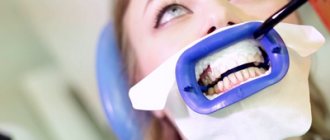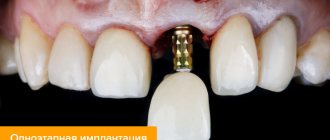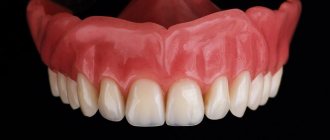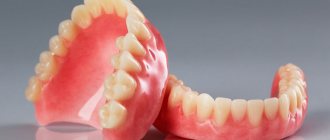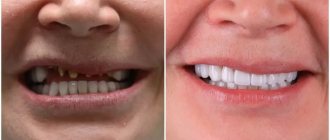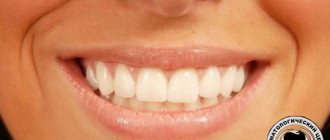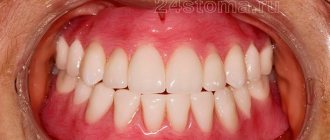Prosthetics for dental defects not only has an aesthetic function - it is an important stage in restoring chewing efficiency, on which the overall health of the body directly depends. In the absence of one, two, or maximum three teeth in a row and the presence of two supporting teeth, as a rule, the method of fixed prosthetics with bridges is used. These designs have excellent aesthetic characteristics, and their production takes from several days to 2-3 weeks.
Metal-ceramic dentures are one of the most popular types of fixed prosthetics.
How much does cermet cost?
Structure of a metal-ceramic crown:
- The inner layer of the product is a metal frame.
- A layer of ceramic is applied to the frame on top.
The cost of metal-ceramic crowns depends on:
- The material from which the inner layer is made. For example, a crown with a frame made of gold or platinum will cost more than the same one, only with an inner layer of cobalt-chrome alloy.
- Method of crown installation. Preservation of the tooth root eliminates the need to install an implant and reduces the cost of the prosthetic procedure.
We present here the price for installing turnkey metal-ceramic crowns in St. Petersburg.
| Crown installation method | Cost, rubles |
| on your teeth | from 14 000 |
| on an implant | from 25 000 |
What prostheses are made from metal-ceramics?
Metal-ceramics are two-component dental products consisting of an internal metal frame and an external ceramic coating. To make the frame, chemically and biologically neutral metals and their alloys are used - gold, platinum, titanium, chromium-nickel alloy, etc. The ceramic coating provides the necessary abrasion resistance, and also performs an aesthetic function, giving the product a resemblance to natural teeth. Our clinic uses metal ceramics in all types of prostheses:
- removable;
- fixed;
- dental bridges;
- for implants;
- dental crowns.
In most cases, metal ceramics are the most suitable material for dentures.
Types of metal-ceramic crowns
The quality of metal-ceramics is determined by the material from which the artificial tooth frame is made. Let's look at the advantages and disadvantages of different types of metal-ceramic crowns.
Alloys based on precious metals
Gold, platinum, and palladium are used to make the frame. The alloys of these metals have a light yellow tint, which, along with the biological inertness of the materials, explains the main advantages of crowns:
- The natural shade of the surface in any direction of light allows the use of such restorations in the smile area.
- It is extremely rare to cause intolerance reactions.
- They do not oxidize under the influence of saliva, which significantly increases the service life of the product.
- When in contact with the edge of the gums, they do not cause darkening of the soft tissues.
- Compared to alloys of base metals, the natural shade of the restoration can be achieved with a thinner layer of ceramics. This allows you to reduce the thickness of the entire structure and ensure the minimum possible gap between the tooth and the crown during installation.
In terms of cost, gold-platinum crowns are on average twice as expensive as metal-ceramics on a frame made of base metals.
Titanium metal ceramics
Titanium is actively used in all areas of medicine due to its strength and absolute bioinertness. Titanium crowns with ceramic coating are valued by dentists for:
- No intolerance or allergy reactions.
- Lightweight structures, which is important for long prostheses.
- Corrosion resistance.
- Durability. Often a person can wear a titanium metal-ceramic crown throughout his life.
The disadvantages of titanium restorations include technical difficulties associated with the manufacture of products. Only special titanium ceramics can be applied to a titanium frame. During implantation, titanium crowns can only be installed on titanium implants and abutments.
Base metal alloys
Alloys of various compositions are used in dentistry. For example, the advantages of a cobalt-chromium alloy are high hardness, strength, biocompatibility, and corrosion resistance.
The disadvantages of such alloys included:
- Possible allergic reactions, especially if the alloy contains nickel.
- Darkening of the gums at the point of contact of the soft tissues with the inner layer of the crown.
- The unaesthetic appearance of the crown, when when the gums sag, a gray metal rim becomes noticeable at the point of contact between the tooth enamel and the crown material.
- Unnatural appearance of restorations, which limits their use for restoring anterior teeth.
Now, metal-ceramics are made with an all-porcelain edge (with a shoulder mass): an additional layer of ceramics completely isolates the metal base from contact with saliva and the gum edge, thereby preventing the development of undesirable effects.
When and why are dental crowns installed?
Metal ceramics can be installed on:
- The patient’s own teeth, when the tooth root is not damaged, but the chewing element has significant defects.
- Implants implanted into the jaw bone instead of the root of a tooth.
- Bridges.
- Clasp dentures.
Indications for installing a crown on your own teeth include:
- More than 50% tooth decay.
- Mechanical damage (fractures, chips).
- Significant reduction in tooth height due to abrasion of enamel.
Implants are placed in place of a tooth that has been removed by the root. 1 lost tooth in the dentition requires 1 implant. If 3 or more units in a row are missing, you can limit yourself to two implants on which a bridge will be installed. The bridge can also be fixed on the patient’s own teeth, as a rule, after they have been previously depulped and ground down.
Prices for dental prosthetics with metal-ceramics in St. Petersburg
| Metal-ceramic crown for tooth + with work | Cost - 12,000 rubles. |
| Crown treatment | + |
| Taking impressions | + |
| Intermediate visit with fitting and choice of color for the future design | + |
| Permanent cementation | + |
Advantages of prosthetics with metal-ceramic crowns
- Durability, long service life. Products are used for at least 15 years.
- Aesthetics of natural dentition. The similarity of the prosthesis to ordinary teeth is extremely high; the metal base is noticeable only when light falls on it at a certain angle.
- Unchanging color. Ceramics are not painted with food dyes and retain their original color throughout their service life.
- Restoration of chewing function. Properly installed metal-ceramics can withstand chewing loads on a par with regular teeth, without restrictions.
- Maximum preservation of the main teeth. Thanks to the thin walls of the crowns, the supporting molars undergo minimal filing and retain all their functions for many years.
- Hypoallergenic. The metal base is made from harmless hypoallergenic alloys that do not enter into chemical reactions with biological fluids of the body.
- Availability. Compared to non-metallic prostheses, metal-ceramics require much lower financial costs.
Metal-ceramic crowns: pros and cons
Let's look at the advantages of metal-ceramic prostheses.
Hygiene
Bacteria practically do not settle on the ceramic surface. The materials do not have a negative effect on the microflora of the oral cavity, which allows the use of this type of crowns for people with oral diseases.
Durability
Metal-ceramic restorations are resistant to abrasion and deformation. They do not change color when exposed to food dyes or tobacco smoke. The service life of metal ceramics largely depends on the material from which the frame is made and averages from 10 to 15 years.
Versatility
Metal-ceramic dentures can be used to restore any teeth in the oral cavity. These crowns on the lateral areas of the teeth withstand the chewing load well, and in the smile area they are indistinguishable in appearance from a person’s own teeth.
Price
Metal ceramics are much cheaper than solid ceramic and zirconium crowns and are not much inferior in quality.
A significant disadvantage of metal-ceramics is the likelihood of chips and cracks in the ceramic layer.
Care and features of using metal-ceramic structures
For those who need a relatively inexpensive and aesthetic fixed prosthesis, metal ceramics, the price of which is quite reasonable, is the ideal choice. It is easy to care for and requires the same care as your own teeth. You should brush your teeth at least twice a day after meals, and be sure to rinse your mouth after eating during the day.
Make an appointment with a doctor
- +7
- Smolenskaya st., 9 Make an appointment
- St. Badaeva, 6, bldg. 1 Make an appointment
- Menedeleev Boulevard, 9, bldg. 1 Make an appointment
- Turistskaya st., 10 Make an appointment
Turnkey metal-ceramic crown: installation steps
Let's consider two routine situations for prosthetic dentists.
| Stages of prosthetics | On your own tooth | On implant |
| Initial consultation | The installation of crowns is preceded by an examination by a dentist, an x-ray examination, drawing up a prosthetic plan, and agreeing on the timing and cost of treatment with the patient. | |
| Preparation | Treatment of carious teeth, removal of teeth that cannot be treated, and professional oral hygiene procedures are carried out. If necessary, old fillings are replaced. | |
| Stage 1 | Preparing a tooth for installation of a crown usually includes depulping, root canal filling, and installing a pin or stump inlay. The tooth enamel is ground down to the thickness of the prosthesis (1.5-2 mm). | In place of the removed tooth root, an implant is installed into the jaw bone tissue. The artificial root can be covered with gum during healing (for up to 6 months), or a temporary crown can be installed on it, which will then be replaced with a permanent one. |
| Stage 2 | Metal-ceramic crowns are made individually for each person using impressions in a dental laboratory. At the first stage, a metal frame is cast, which is then covered with layers of ceramics. After firing, the product is additionally covered with a layer of glaze to match the color of the patient’s enamel. | |
| Stage 3 | After fitting and fitting the crown, it is permanently fixed in the dentition. | |
How is a metal-ceramic crown attached? There are two main methods of fixation:
- For cement. Special dental cement is applied to the prepared tooth stump or abutment (an adapter between a titanium implant and a crown), after which a cap-like prosthesis is placed on top.
- On the screw. Screws are used only when fixing crowns to implants. In this case, the prosthesis has a screw shaft on its chewing surface, which, after installing the crown, is closed with filling material.
The timing of installation of metal-ceramic crowns is determined by the time of their manufacture in the dental laboratory. On average, 10 days pass between preparing for prosthetics and installing metal ceramics on your teeth. During implantation, permanent fixation of the crown is carried out after complete engraftment of the artificial root, that is, 4-6 months after the operation to install the implant.
Still have questions about metal-ceramic crowns?
When choosing a prosthetic technique, the patient needs to at least superficially know about the materials that will be used in the manufacture of teeth. Today the market offers a large selection - our specialists will definitely advise you on all issues and select the best option based on your characteristics.
The final cost of the product will be announced at the initial appointment. We guarantee the high quality of work of all specialists - experienced doctors will do the work to the highest standard, and you can be sure of the correctness of all manipulations. Already at the initial examination, we will announce prices for dental prosthetics in St. Petersburg and the types of dentures that are individually suitable for you.
How to care for metal-ceramic crowns?
Oral care after dentures is simple. Several rules must be followed:
- You should not test the strength of metal ceramics by cracking nuts with your teeth, opening lids, or biting threads. Excessive load can lead to chipping of the ceramic layer.
- When brushing your teeth, you need to pay special attention to the areas where the crown comes into contact with the gums, as food particles can get stuck in this gap. The best way to remove them is to use a waterpik after brushing and flossing.
- Once a year, it is recommended to carry out a professional oral hygiene procedure to remove bacterial plaque and tartar.
Possible complications when installing a dental crown
Problems with metal-ceramic crowns are not that common. However, it is worth having an idea about them.
Inflammation
The pressure of the prosthesis on the gum, a significant gap between the lower edge of the prosthesis and the gingival edge can cause inflammation of the soft tissues. The main signs of the inflammatory process are swelling and redness around the problematic tooth. Without treatment, gingivitis can develop into periodontitis, in which the inflammatory process moves from the gums to the entire array of tissues surrounding the tooth root.
Caries and pulpitis under the crown
A fixed prosthesis is installed on a completely healthy or specially prepared tooth. If preparation for prosthetics was not carried out carefully enough, carious tooth destruction under restoration gradually progresses and without treatment can lead to the formation of a dental cyst or periodontal abscess.
Periodontitis
Errors made when planning prosthetics can lead to inadequate mechanical load on the teeth under the crown or bridge. Such inadequate load over time leads to loosening of the tooth, destruction of its attachment to the jaw bone and subsequent loss.
Malocclusion and its consequences
Excessively low or, conversely, too high metal-ceramic crowns disrupt the chewing process. This overloads the temporomandibular joint and causes the development of pathological changes in it. The pathology manifests itself as pain in the joints after eating, and the appearance of clicking sounds when opening the mouth. Neurological disorders may also occur, the most typical symptoms of which are headaches and even hearing loss.
Fractures of bridges and individual crowns
The use of modern materials and methods of their processing in the production of restorations virtually eliminates the possibility of a fracture of an individual crown. Damage to a bridge can result from excessive mechanical stress or technical errors in its manufacture.
As you can see, most of the possible problems that arise when installing crowns can be avoided if you turn to professionals who take into account all significant factors when planning treatment.
Repair and restoration of metal-ceramic crowns
Loss of the aesthetic appearance of the crown due to the appearance of chips and cracks in the ceramic layer is not a problem. Damaged areas can be restored using composite materials.
The restoration procedure resembles the process of caries treatment, when an enamel defect is closed with a filling of a suitable shade. All manipulations are carried out in the patient’s oral cavity and do not require preliminary removal of the denture, but such a repair may not be very durable.
If dentures are significantly damaged and the metal frame is affected, they may need to be replaced. Old crowns are sawed down and removed, then impressions are taken and sent to a dental laboratory.
While new restorations are being made, the patient is not left without teeth thanks to the use of temporary crowns made of plastic. After fitting and fitting, the new permanent crown is installed in place of the old one.
Indications and contraindications for installing metal ceramics
The dentist will suggest installing metal-ceramic crowns if you have:
- destruction of dental tissue covered more than half of the molar;
- one or more teeth are completely missing;
- The carious lesion has spread to the area below the gum line.
Although metal ceramics have minimal contraindications for installation, in some cases prosthetics are considered undesirable or even dangerous. As a rule, a doctor refuses treatment if a patient has:
- chronic periodontitis;
- malocclusion;
- bruxism (teeth grinding reflex while sleeping);
- untreated inflammatory process in the oral cavity;
- mental illness;
- pregnancy;
- recovery period after a serious illness, surgery, injury.
Some of these contraindications are temporary, and after successful treatment, metal-ceramic prostheses, as a rule, are still installed. But if you have any of the diseases, it is better to refuse dental restoration without hiding your condition from the doctor. Otherwise, a weakened body may not be able to cope with the implantation of crowns.
Stages of metal-ceramic prosthetics
- Preparation. It is necessary to take an X-ray of the jaws to identify and eliminate existing problems: heal caries, fill root canals, relieve the inflammatory process.
- Grinding of teeth. The dentist removes a layer of hard tissue corresponding to the thickness of the crowns (about 1 mm).
- Taking an impression. An impression of both jaws is made.
- Installation of temporary crowns. As a rule, they are worn for aesthetic purposes, since a large load on them when eating food is contraindicated.
- Manufacturing of prostheses. In the laboratory, a metal alloy frame is made from an impression. The shape of each frame exactly matches the surface of the treated tooth. The finished frames are covered with ceramic cladding.
- Fitting, prosthetics. The crowns are placed and secured with a temporary cement compound to identify possible inaccuracies and correct the shape.
- Consolidation. After eliminating the uncomfortable elements, the products are fixed with permanent, strong cement.
Care and service life of metal-ceramic dentures
The smooth surface of metal ceramics does not allow bacteria and food debris to accumulate on their surface.
However, ordinary hygiene procedures twice a day remain a necessity even when the entire dentition has undergone prosthetics. With regular care and careful treatment of artificial teeth, the service life of metal ceramics is 13-15 years. It is not recommended to test the strength of dentures by chewing too hard food - crackers, nuts, etc., so as not to provoke the detachment of the ceramics from the metal base. SIGN UP
PRICES
STOCK
HOW TO GET THERE
Photos before and after installing metal-ceramic crowns on teeth
An example of restoration of 3 broken and 1 protruding upper front teeth with metal-ceramics.
In the first photo, 2 upper lateral incisors are missing. On the second, metal-ceramic crowns on implants were installed in place of the missing teeth. A professional oral hygiene procedure, during which plaque and tartar are removed, makes your smile perfect.
Metal-ceramic crowns are installed on implants. In the first photo, one central incisor has been ground for an artificial crown and 3 artificial roots have been installed.
Artificial crowns were used to replace 2 removed lower incisors, as well as 2 destroyed lower incisors and 2 canines. As a result, the lower dentition looks ideal and at the same time absolutely natural.
In the first photo, the teeth are ground for crowns. The second photo is the result of restoration of the front teeth of the upper jaw with crowns. In terms of shade and wet shine, metal-ceramics are no different from the patient’s own teeth.
Our experience working with people shows that price matters. Therefore, we are ready to provide the best conditions for installing metal-ceramic crowns at affordable prices and with a guarantee of results. Want to know how much prosthetics will cost? Dial our clinic number, sign up for a consultation and get the best price offer. There is a system of individual discounts depending on the final cost of services.


